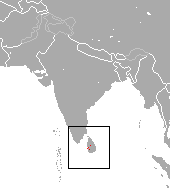
Felidae is a family of mammals in the order Carnivora, colloquially referred to as cats. A member of this family is also called a felid. The term "cat" refers both to felids in general and specifically to the domestic cat.

The IUCN Red List of Threatened Species, founded in 1965, has evolved to become the world's most comprehensive inventory of the global conservation status of biological species. It uses a set of criteria to evaluate the extinction risk of thousands of species and subspecies. These criteria are relevant to all species and all regions of the world, With its strong scientific base, the IUCN Red List is recognized as the most authoritative guide to the status of biological diversity. A series of Regional Red List are produced by countries or organizations, which assess the risk of extinction to species within a political management unit.

Hoya carnosa, the porcelainflower or wax plant, is an Asclepiad species of flowering plant in the dogbane family Apocynaceae. It is one of the many species of hoya that are native to Eastern Asia and Australia. It is a common house plant grown for its attractive waxy foliage, and sweetly scented flowers.

Python is a genus of constricting snakes in the Pythonidae family native to the tropics and subtropics of the Eastern Hemisphere. Currently, 10 python species are recognized.

Heliophila is a genus of flowering plants in the family Brassicaceae. Members of this genus are either annuals or perennials and some are popular as ornamental plants. Endemic to southern Africa, the majority of the approximately 80 species grow in South Africa, particularly the Cape Floristic Region, while a few extend into the Namib Desert.

A critically endangered (CR) species is one that has been categorized by the International Union for Conservation of Nature (IUCN) as facing an extremely high risk of extinction in the wild.
Heller's pipistrelle is a species of vesper bat.
Melck's house bat is a species of vesper bat.

The Japanese mountain mole is a species of mammal in the family Talpidae. It is endemic to Japan. Its natural habitats are temperate forests and temperate grassland. Although the Japanese mountain mole is currently classified in the genus Euroscaptor, a study published by the American Society of Mammalogists suggests that they do not truly belong to this genus because of earlier evolutionary divergence from other Euroscaptor species.

The jungle shrew is a species of mammal in the family Soricidae endemic to Sri Lanka. Its natural habitat is subtropical or tropical dry forests. It is threatened by habitat loss.

The Aldabra flying fox is a species of megabat in the genus Pteropus. It is endemic to the Aldabra Atoll in the Seychelles, like Chaerephon pusilla, though the latter may be the same species as the little free-tailed bat.
Horsfieldia carnosa is a plant species in the family Myristicaceae. It is a tree endemic to Borneo.

Bat Conservation International (BCI) is an international non-governmental organization working to conserve the world's bats and their habitats through conservation, education and research efforts.

The Australian grey smooth-hound or grey gummy shark is a species of houndshark, belonging to the family Triakidae, native to the Pacific Ocean and Indian Ocean waters surrounding Australia. The shark is widespread in deep coastal waters.
The white-fin smooth-hound is a species of tropical houndshark, and part of the family Triakidae, found in the Bali and Indonesia areas of the Western Pacific.

The World's 25 Most Endangered Primates is a list of highly endangered primate species selected and published by the International Union for Conservation of Nature Species Survival Commission Primate Specialist Group, the International Primatological Society (IPS), and Conservation International (CI). The 2012–2014 list added the Bristol Conservation and Science Foundation (BCSF) to the list of publishers. The IUCN/SSC PSG worked with CI to start the list in 2000, but in 2002, during the 19th Congress of the International Primatological Society, primatologists reviewed and debated the list, resulting in the 2002–2004 revision and the endorsement of the IPS. The publication has since been a joint project between the three conservation organizations and has been revised every two years following the biannual Congress of the IPS. Starting with the 2004–2006 report, the title changed to "Primates in Peril: The World's 25 Most Endangered Primates". That same year, the list began to provide information about each species, including their conservation status and the threats they face in the wild. The species text is written in collaboration with experts from the field, with 60 people contributing to the 2006–2008 report and 85 people contributing to the 2008–2010 report. The 2004–2006 and 2006–2008 reports were published in the IUCN/SSC PSG journal Primate Conservation, while the 2008–2010 and 2010-2012 report were published as independent publications by all three contributing organizations.
Aeranthes carnosa is a species of orchid native to the east coast of Madagascar.

Andrew Rebori's house bat is a species of bat found in Africa.

Ejeta's house bat is a species of vesper bat found in Ethiopia. It was described as a new species of bat in 2014.
















